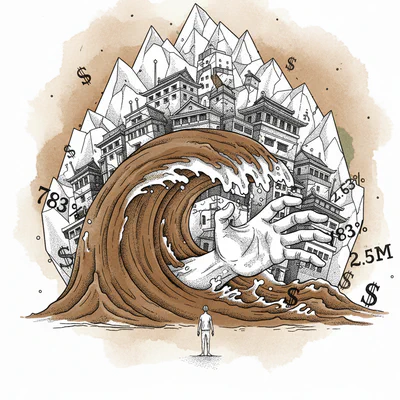The procedural invalidation of a local plan for attractive plots near the Łagiewnicki Forest buffer zone in Łódź. How changing one word in a resolution suspends a multi-year planning process, exposing the system's fragility and raising questions about who truly benefits from procedural chaos.
Table of Contents
Residents of a Łódź neighborhood could feel a sense of satisfaction after months of fighting for spatial order. In September 2025, the Łódź City Council passed the long-awaited Local Spatial Development Plan (Resolution No. XXI/581/25) for the area around Łupkowa, Strykowska, and Książka streets. The document was meant to end disputes and curb urban chaos. It seemed the battle was over.
Nothing could be further from the truth. On October 17, 2025, the Łódź Voivode initiated a supervisory proceeding that effectively suspends the entire plan. The reason? An error so trivial it’s hard to believe it was accidental, an error that could render the months-long effort of residents and officials completely wasted.

Anatomy of an Error
The core of the problem lies in one key paragraph of the resolution – § 20, section 1. As the voivode himself points out in his notice, the documentation during the consultation and opinion stages was correct:
“1. For the areas from 1MNS to 4MNS, the provisions contained in the following sections of this paragraph shall apply.”
A logical and simple statement – it covers all four designated single-family housing areas. However, in the version that was voted on and adopted by the Council, the same passage reads differently:
“For the areas 1MNS and 4MNS, the provisions contained in the following sections of this paragraph shall apply.”
This seemingly minor change – replacing the range “from… to…” with the conjunction “and” – is a legal bombshell. It magically excluded the 2MNS and 3MNS areas from the plan’s key regulations. As the supervisory authority states, for these two areas, no purpose, building parameters (intensity, height, biologically active area), or land division rules were specified at all.
In other words, for half of the key areas, the plan is flawed and fails to meet legal requirements.
Who Benefits from the Chaos?
To understand the significance of this “mistake,” one must look back a few months. This very same local plan was the subject of a fierce attack by a group of investors aiming for maximum development intensity. Their arguments were repeatedly rejected at previous stages. The plan had held up on both meritorious and legal grounds, protecting the interests of the local community.
Now, due to an “accidental” change, the plan may be invalidated. The result is a return to square one. A return to a state where development can once again be pursued through individual zoning decisions (WZ) – an instrument that works exceptionally well in Łódź, a city described by the industry as “the most developer-friendly in Poland.”
This accidental error, therefore, benefits the exact group that lost the battle over the plan’s content on its merits. It is a textbook example of how the system can be exploited to achieve private goals, even against the will of the residents and after the formal process has concluded.
The Questions Residents Are Asking
The situation is more than just a local drama for one neighborhood. It is a case study that reveals how illusory control over the legislative process can be. Among the residents involved, fundamental questions are now circulating:
- Who made this change, and at what stage? The text didn’t change by itself. It must have happened between the consultation phase and the final vote. Who had access to the document, and who is responsible?
- How did a flawed version pass through all verification filters? Where was the City’s Legal Office? Where were the City Council committees? Did no one notice that a key provision had been altered in a way that made the resolution illegal?
- Is this incompetence or a deliberate act? This is the most frequently asked question. If it is extreme incompetence, it compromises the entire administrative and legal oversight apparatus of the city. If it was deliberate, we are dealing with the sabotage of democratic procedures.
Regardless of the answer, the effect is the same: years of work by residents, urban planners, and some officials are thrown away. Trust in public institutions is once again brutally undermined. In a country where procedures are often just a facade, this story is a painful reminder that even a won battle does not guarantee winning the war. Especially when your opponent can change the rules of the game just before the final whistle.
Click to see the full text of the Voivode's notice (PNIK-I.4131.718.2025)
ŁÓDZKI URZĄD WOJEWÓDZKI W ŁODZI 90-926 Łódź, ul. Piotrkowska 104, tel.: (+48) 42 664 10 00, fax: (+48) 42 664 10 40 Elektroniczna Skrzynka Podawcza ePUAP: /lodzuw/SkrytkaESP https://www.gov.pl/web/uw-lodzkiAdministratorem danych osobowych jest Wojewoda Łódzki. Dane przetwarzane są w celu realizacji czynności urzędowych. Masz prawo do dostępu, sprostowania, ograniczenia przetwarzania danych. Więcej informacji znajdziesz na stronie https://www.gov.pl/web/uw-lodzki w zakładce ochrona danych osobowych. Id: 531706E9-A838-47BD-85F3-992D22CF7D3C WOJEWODA ŁÓDZKI Łódź, dnia 17 października 2025 r. PNIK-I.4131.718.2025 Rada Miejska w Łodzi Zawiadomienie o wszczęciu postępowania Na podstawie art. 91 ust.5 ustawy z dnia 8 marca 1990 r. o samorządzie gminnym (Dz. U. z 2024 r. poz. 1465, 1572, 1907 i 1940) w związku z art. 61 § 1 i 4 ustawy z dnia 14 czerwca 1960 r. – Kodeks postępowania administracyjnego (Dz. U. z 2024 r. poz. 572) zawiadamiam, że wszczęte zostało z urzędu postępowanie określone w rozdziale 10 ustawy z dnia 8 marca 1990 roku o samorządzie gminnym w celu kontroli legalności uchwały Nr XXI/581/25 Rady Miejskiej w Łodzi z dnia 24 września 2025 r. w sprawie uchwalenia miejscowego planu zagospodarowania przestrzennego dla części obszaru miasta Łodzi położonej w rejonie ulic: Łupkowej, Strykowskiej i Antoniego Książka, której pełna dokumentacja wpłynęła do Łódzkiego Urzędu Wojewódzkiego w Łodzi w dniu 1 października 2025 r. Uzasadnienie W wyniku kontroli legalności przedmiotowej uchwały, organ nadzoru stwierdził, co następuje: 1) Na rysunku planu miejscowego, stanowiącego załącznik Nr 1 do uchwały, wyznaczono „liniami rozgraniczającymi tereny o różnym przeznaczeniu lub różnych zasadach zagospodarowania", tereny o symbolach 2MNS oraz 3MNS, dla których w części tekstowej uchwały nie ustalono: - przeznaczenia, co stanowi naruszenie art. 15 ust. 2 pkt 1 ustawy z dnia 27 marca 2003 r. o planowaniu i zagospodarowaniu przestrzennym (Dz. U. z 2024 r. poz. 1130 z późn. zm.), zwanej dalej „ustawą pzp", oraz § 4 pkt 1 rozporządzenia Ministra Rozwoju i Technologii z dnia 17 grudnia 2021 r. w sprawie wymaganego zakresu projektu miejscowego planu zagospodarowania przestrzennego (Dz. U. poz. 2404), zwanego dalej „rozporządzeniem mpzp", - maksymalnej i minimalnej nadziemnej intensywności zabudowy, minimalnego udziału powierzchni biologicznie czynnej, maksymalnej wysokości zabudowy dla budynków gospodarczych i garaży, co stanowi naruszenie art. 15 ust. 2 pkt 6 ustawy pzp oraz § 4 pkt 7 lit. a rozporządzenia mpzp. 2) Dla terenu o symbolu 3MNS, nie ustalono szczegółowych zasad i warunków scalania i podziału nieruchomości. Nie określono parametrów działek uzyskiwanych w wyniku scalania i podziału nieruchomości, w szczególności minimalnych lub maksymalnych szerokości frontów działek oraz ich powierzchni, jak również kąta położenia granic działek w stosunku do pasa drogowego lub linii rozgraniczających teren drogi; co stanowi naruszenie art. 15 ust. 2 pkt 8 ustawy pzp oraz § 4 pkt 9 lit. a-b rozporządzenia mpzp. 3) Dla terenu o symbolu 2MNS, nie ustalono wszystkich szczegółowych zasad i warunków scalania i podziału nieruchomości, tj. nie określono parametrów działek uzyskiwanych w wyniku scalania i podziału nieruchomości, w postaci powierzchni działek oraz minimalnych lub maksymalnych szerokości frontów działek, co stanowi naruszenie art. 15 ust. 2 pkt 8 ustawy pzp oraz § 4 pkt 9 lit. a-b rozporządzenia mpzp. Jak wynika z ustaleń szczegółowych dla terenów zabudowy mieszkaniowej jednorodzinnej szeregowej lub grupowej o symbolach MNS, zawartych w § 20 ust. 1 uchwały: „Dla terenów 1MNS i 4MNS obowiązują ustalenia zawarte w kolejnych ustępach niniejszego paragrafu." Zatem, na skutek zastosowania powyższego spójnika „i", zamiast np. myślnika albo zakresu „od/do" oraz wyszczególnienia w treści § 20 ust. 1 uchwały tylko terenów o symbolach 1MNS oraz 4MNS, następujące dalej w treści § 20 ustalenia szczegółowe, dotyczą tylko terenów 1MNS i 4MNS, chyba że tereny o symbolach 2MNS oraz 3MNS, zostały dodatkowo wyszczególnione, jak, np. w treści § 20 ust. 3 pkt 1 lit a. tiret drugie i trzecie, pkt 2 lit. a tiret pierwsze i drugie oraz lit. b tiret pierwsze i drugie. Z analizy dokumentacji prac planistycznych oraz informacji zawartych na ogólnodostępnej stronie Miejskiej Pracowni Urbanistycznej w Łodzi, wynika, że na etapie uzgodnień i opiniowania projektu przedmiotowej uchwały treść ww. § 20 ust. 1 uchwały brzmiała następująco: „1. Dla terenów od 1MNS do 4MNS obowiązują ustalenia zawarte w kolejnych ustępach niniejszego paragrafu". Natomiast na etapie konsultacji społecznych oraz w przedmiotowej uchwale, przyjętej przez radę, treść § 20 ust. 1, brzmiało już następująco: „Dla terenów 1MNS i 4MNS obowiązują ustalenia zawarte w kolejnych ustępach niniejszego paragrafu." Wobec powyższego, w terminie do 23 października 2025 r. proszę o złożenie wyjaśnień w przedmiotowej sprawie. Wyjaśnienia należy przesłać do Łódzkiego Urzędu Wojewódzkiego w Łodzi na adres Elektronicznej Skrzynki Podawczej ePUAP: /lodzuw/enadzor albo ePUAP: /lodzuw/skrytka. WOJEWODA ŁÓDZKI Dorota Ryl Elektronicznie podpisany przez: Dorota Helena Ryl dnia 17 pa dziernika 2025 r. Do wiadomości: Prezydent Miasta Łodzi





